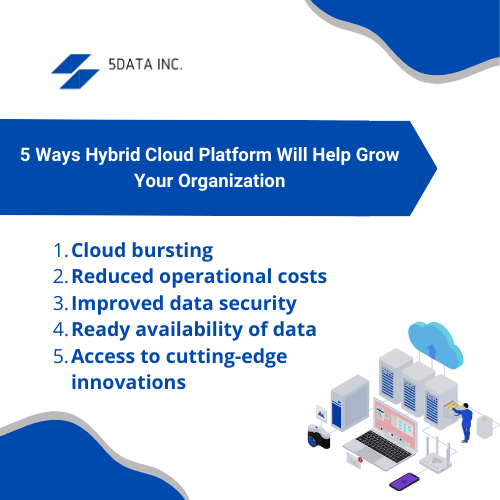What we cover in this blog
Hybrid Cloud Architecture: What Is It?
An IT architecture known as a hybrid cloud enables the orchestration, administration, and mobility of workloads between two or more domains. A bare-metal environment linked to one or many public and/or private clouds, as well as at least one private cloud platform and one public cloud platform, are typical hybrid cloud situations.
In the past, hybrid cloud architecture centered on first converting a few on-site infrastructures to public cloud technology and then integrating it into an off-site public cloud platform. This required sophisticated corporate middleware for integrating cloud resources across various environments and centralized management systems to monitor, distribute, and manage resources centrally.
Physical connection is less of a priority in today’s hybrid cloud architecture than mobility and automation of the deployment of workloads across all platforms. Building an open, integrated hybrid cloud platform requires cloud-native technologies, microservices, containers, and infrastructure virtualization.
5 Ways Hybrid Cloud Platform Will Help Grow Your Organization
1.Cloud bursting to meet increased consumer demands
With a hybrid cloud environment, businesses can meet spikes in demand for applications or services without incurring the hefty expenses of overstuffing their data centers. Configure your apps to burst into the public cloud during periods of high demand when extra resources for computing are needed to provide the necessary capacity and guarantee customer satisfaction. Your applications should typically run on private clouds or on-premises.
Businesses and organizations that frequently experience swings in demand for data and application services benefit the most from cloud bursting. For instance, the demand for financial apps increases during tax season and after each quarter. Another instance is the retail sector, when holidays like Christmas and Black Friday lead to increased site traffic and sales. Many organizations can maintain excellent customer experiences during heavy application demand by cloud bursting.
2.Reduced operational and IT costs
Over the past five years, adopting hybrid clouds has been driven by major strategic goals such as reducing IT spending and lowering the total cost of ownership. Businesses that rely on local infrastructure and data centers require enough servers to satisfy consumer demands during periods of high usage. A company could spend money on 500 servers to handle peak demand but only need 200 servers during “average” or “regular” demand times. IT resources are underutilized, and money is wasted by purchasing for peak demand.
In comparison, an organization utilizing hybrid cloud capabilities may spend just $200 on 200 servers and rely on third parties to provide more capacity when demand is at its highest. These firms gain from better rates of IT resource utilization, better cost control, and more effective IT investment.
3.Improved data security, disaster recovery, and business continuity
Organizations have more options for data security thanks to the hybrid cloud approach. Businesses may keep their most sensitive data in the on-site data center, which is harder for hackers to access. Use public cloud storage simultaneously to quickly and conveniently analyze less-sensitive data. The hybrid cloud environment is now creating portable apps that can function on private or public cloud infrastructure. When a company has a service outage and needs to implement its disaster recovery plan to ensure business continuity and prevent unplanned downtime that has a negative impact on the overall customer experience, portable apps provide a substantial competitive advantage.
4.Applications and data readily available to remote workers
With the necessary authorization, members of your company can access the data (customer data) and apps housed in the cloud from any global location. On the other hand, accessing data and applications hosted in on-premise data centers may be challenging or involve unacceptably long lag times for users in other regions. By utilizing their infrastructure, employers who use hybrid cloud solutions may give their staff remote access to on-premises and cloud-based data and apps.
5.Access to cutting-edge innovations and cloud services
Organizations with a hybrid cloud model benefit from the greatest flexibility in finding and adopting best-of-breed technology and cloud services to serve any application’s critical workloads. Significant competitive advantages can be created by deploying any application to the computer environment that guarantees the highest performance, lowest prices, and most dependable service. By incorporating many public cloud services into their hybrid cloud solution, organizations may increase their access to technology while avoiding cloud vendor lock-in.

Conclusion
Hybrid clouds are a common choice for cloud adoption because they combine the scale and flexibility of public clouds with the security and management of assets found in on-premises or private clouds. Suppose you are looking for professional cloud specialists to develop the best hybrid cloud strategy which is cost-effective and maximizes the performance of your hybrid cloud infrastructure. That’s where we step in for you. The cloud specialists at our hybrid cloud development company 5Data Inc can assist in your planning and creation of the ideal open unified hybrid cloud solution for your company.
We at 5Data Inc. provide robust cloud technology products that assist businesses in getting the most out of their investments in hybrid cloud strategy. We enable businesses to maximize the most of their big data assets while replicating and safeguarding on-premise operations.

Annanya Adyasha
Author
